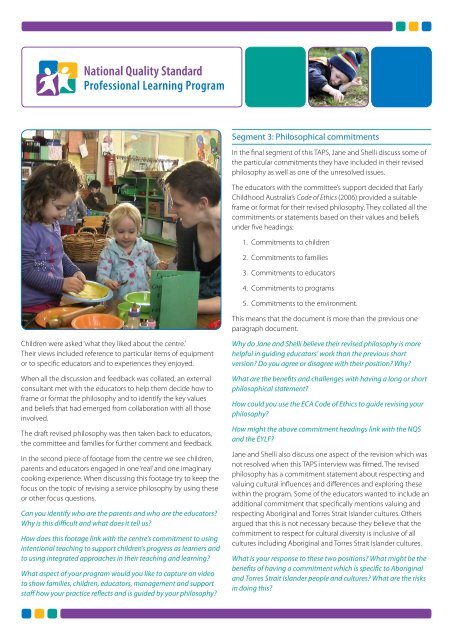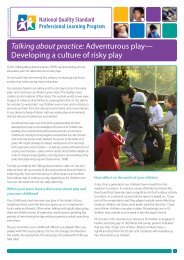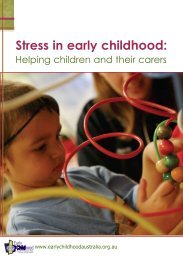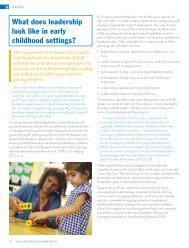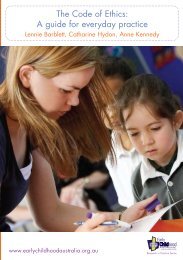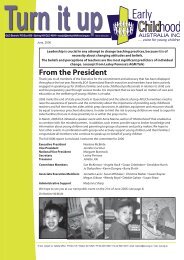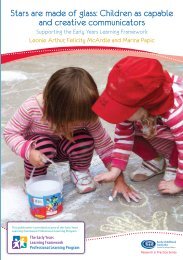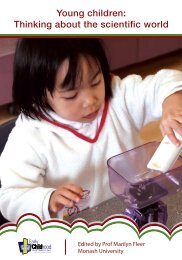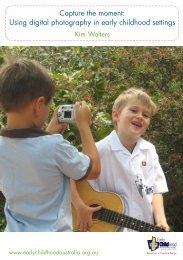suggestions - Early Childhood Australia
suggestions - Early Childhood Australia
suggestions - Early Childhood Australia
Create successful ePaper yourself
Turn your PDF publications into a flip-book with our unique Google optimized e-Paper software.
Children were asked ‘what they liked about the centre.’<br />
Their views included reference to particular items of equipment<br />
or to specific educators and to experiences they enjoyed.<br />
When all the discussion and feedback was collated, an external<br />
consultant met with the educators to help them decide how to<br />
frame or format the philosophy and to identify the key values<br />
and beliefs that had emerged from collaboration with all those<br />
involved.<br />
The draft revised philosophy was then taken back to educators,<br />
the committee and families for further comment and feedback.<br />
In the second piece of footage from the centre we see children,<br />
parents and educators engaged in one ‘real’ and one imaginary<br />
cooking experience. When discussing this footage try to keep the<br />
focus on the topic of revising a service philosophy by using these<br />
or other focus questions.<br />
Can you identify who are the parents and who are the educators?<br />
Why is this difficult and what does it tell us?<br />
How does this footage link with the centre’s commitment to using<br />
intentional teaching to support children’s progress as learners and<br />
to using integrated approaches in their teaching and learning?<br />
What aspect of your program would you like to capture on video<br />
to show families, children, educators, management and support<br />
staff how your practice reflects and is guided by your philosophy?<br />
Segment 3: Philosophical commitments<br />
In the final segment of this TAPS, Jane and Shelli discuss some of<br />
the particular commitments they have included in their revised<br />
philosophy as well as one of the unresolved issues.<br />
The educators with the committee’s support decided that <strong>Early</strong><br />
<strong>Childhood</strong> <strong>Australia</strong>’s Code of Ethics (2006) provided a suitable<br />
frame or format for their revised philosophy. They collated all the<br />
commitments or statements based on their values and beliefs<br />
under five headings:<br />
1. Commitments to children<br />
2. Commitments to families<br />
3. Commitments to educators<br />
4. Commitments to programs<br />
5. Commitments to the environment.<br />
This means that the document is more than the previous one<br />
paragraph document.<br />
Why do Jane and Shelli believe their revised philosophy is more<br />
helpful in guiding educators’ work than the previous short<br />
version? Do you agree or disagree with their position? Why?<br />
What are the benefits and challenges with having a long or short<br />
philosophical statement?<br />
How could you use the ECA Code of Ethics to guide revising your<br />
philosophy?<br />
How might the above commitment headings link with the NQS<br />
and the EYLF?<br />
Jane and Shelli also discuss one aspect of the revision which was<br />
not resolved when this TAPS interview was filmed. The revised<br />
philosophy has a commitment statement about respecting and<br />
valuing cultural influences and differences and exploring these<br />
within the program. Some of the educators wanted to include an<br />
additional commitment that specifically mentions valuing and<br />
respecting Aboriginal and Torres Strait Islander cultures. Others<br />
argued that this is not necessary because they believe that the<br />
commitment to respect for cultural diversity is inclusive of all<br />
cultures including Aboriginal and Torres Strait Islander cultures.<br />
What is your response to these two positions? What might be the<br />
benefits of having a commitment which is specific to Aboriginal<br />
and Torres Strait Islander people and cultures? What are the risks<br />
in doing this?


